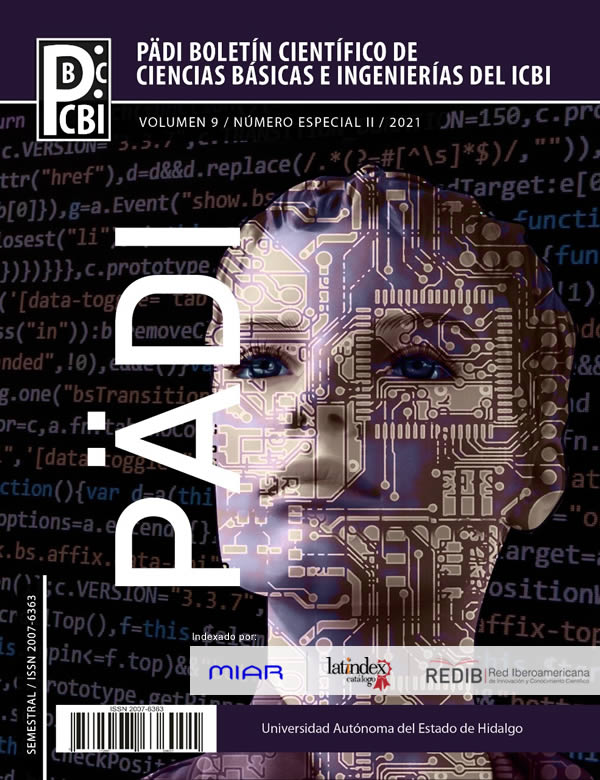Alginate-TiO2 Micro-spheres as curcumin dosing systems
Abstract
Controlled release systems are in increasing development, due to the need that exists to achieve an optimal dosage, in the right place and the control of this dosage for long periods. Curcumin has shown various biological actions, mainly as an antioxidant, anticancer and antibacterial. On the other hand, titanium oxide (TiO2) and alginate (Alg) are widely used in biomedicine as carriers of active substances. In this work, alginate microspheres containing titanium oxide loaded with curcumin were synthesized. The resulting biomaterial showed a spherical morphology. The FTIR-ATR technique demonstrated the formation of the biomaterial, TGA was used to determine the thermal stability of the spheres. Also, the in vitro biocompatibility was evaluated, resulting in that the Alg/TiO2-Cur spheres did not present toxicity in human erythrocytes. Finally, curcumin release was evaluated. Therefore, the Alg/ TiO2-Cur spheres were found to be biocompatible and can be used as efficient vehicles for curcumin release.
Downloads
References
Alexander Maus, Lia Strait, Donghui Zhu., (2021), Nanoparticles as delivery
vehicles for antiviral therapeutic drugs, Engineered Regeneration 2, 31-46,
DOI: 10.1016/j.engreg.2021.03.001.
Ankur Sood, Aastha Gupta, Garima Agrawal., (2021), Recent advances in polysaccharides based biomaterials for drug delivery and tissue engineering applications 2, Carbohydrate Polymer Technologies and Applications. DOI: 10.1016/j.carpta.2021.100067.
Antony V. Samrot, Ujjala Burman, Sheryl Ann Philip, Shobana N, Kumar Chandrasekaran., (2018). Synthesis of curcumin loaded polymeric nanoparticles from crab shell derived chitosan for drug delivery, Informatics in Medicine Unlocked 10, 159-182. DOI: 10.1016/j.imu.2017.12.010.
Deepa Thomas, Neethu Mathew, Megha S. Nath., (2021). Starch modified alginate nanoparticles for drug delivery application. International Journal of Biological Macromolecules 173, 277-284. DOI: 10.1016/j.ijbiomac.2020.12.227
Deepika Shekhawat, Amit Singh, M.K. Banerjee, Tej Singh, Amar Patnaik., (2021). Bioceramic composites for orthopaedic applications: A comprehensive review of mechanical, biological, and microstructural. Ceramics International 47, 3013-3030. DOI: 10.1016/j.ceramint.2020.09.214.
Krishna Mohan Agarwal, Priyanka Singh, Utkarsh Mohan, Shyamal Mandal, Dinesh Bhatia., (2020), Comprehensive study related to advancement in biomaterials for medical applications 1, 100055. DOI: 10.1016/j.sintl.2020.100055.
Fernandes Maria H, Pedro de Sousa Gomes., (2021). Biological Assessment of Bioceramics: In Vitro and in Vivo Tests. Encyclopedia of Materials: Technical Ceramics and Glasses, Elsevier 798-816. DOI: 10.1016/B978-0-12-803581-8.12110-1.
Manoj Aswar, Mangesh Bhalekar, Akshata Trimukhe, Urmila Aswar., (2020). Self-microemulsifying drug delivery system (SMEDDS) of curcumin attenuates depression in olfactory bulbectomized rats. Heliyon. DOI: 10.1016/j.heliyon. 2020.e04482
Maryam Mahjoob, Ursula Stochaj., (2021). Curcumin nanoformulations to combat aging-related diseases. Ageing Research Reviews 69. DOI: 10.1016/j.arr.2021.101364.
M. N. Nadagouda, N. Iyanna, J. Lalley, C. Han, D. D. Dionysiou, R. S Varma., (2014). Synthesis of silver and gold
nanoparticles using antioxidants from blackberry, blueberry, pomegranate, and turmeric extracts. ACS Sustain. Chem. Eng., 2. 1717–1723.
O. Sreekanth Reddy, M.C.S. Subha, T. Jithendra, C. Madhavi, K. Chowdoji Rao., (2021). Curcumin encapsulated dual cross linked sodium alginate/montmorillonite polymeric composite beads for controlled drug delivery. Journal of Pharmaceutical Analysis 11, 191-199. DOI: 10.1016/j.jpha.2020.07.002.
S.A. Iynoon Jariya, Varun Prasath Padmanabhan, Ravichandran Kulandaivelu, Natarajan Prakash, Faruq Mohammad, Hamad A., (2021). Al-Lohedan, Suriati Paiman, Romana Schirhagl, M.A. Motalib Hossain, Suresh Sagadevan. Drug delivery and antimicrobial studies of chitosan-alginate based hydroxyapatite bioscaffolds formed by the Casein Micelle. Chemistry and Physics 272, 125019. DOI: 10.1016/j.matchemphys.2021.125019.
Song Chen, Lulu Shen, Di Huang, Juan Du, Xiaoxu Fan, Aili Wei, Lan Jia, Weiyi Chen., (2021). Facile synthesis, microstructure, formation mechanism, in vitro biocompatibility, and drug delivery property of novel dendr. Materials Science and Engineering: C 115. DOI: 10.1016/j.msec.2020.111100.
Syed Ahmed Shah, Muhammad Sohail, Shujaat Ali Khan, Mubeen Kousar., (2021). Improved drug delivery and accelerated diabetic wound healing by chondroitin sulfate grafted alginate-based thermoreversible. Materials Science and Engineering: C 126, 112169. DOI 10.1016/j.msec.2021.112169.
Tejal V. Patil, Dinesh K. Patel, Sayan Deb Dutta, Keya Ganguly, Tuhin Subhra Santra, Ki-Taek Lim., (2021). Nanocellulose, a versatile platform: From the delivery of active molecules to tissue engineering applications. Bioactive Materials. DOI: 10.1016/j.bioactmat.2021.07.006.
T.S. Anirudhan, V. Manjusha, V. Chithra Sekhar., (2021). A new biodegradable nano cellulose-based drug delivery system for pH-controlled delivery of curcumin. International Journal of Biological Macromolecules 183. 2044-2054. DOI: 10.1016/j.ijbiomac.2021.06.010
Tzipatly A. Esquivel-Castro, M.C. Ibarra-Alonso, J. Oliva and Antonia Martínez Luévanos., (2019), Porous aerogel and core/shell nanoparticles for controlled drug delivery: A review. Materials Science and Engineering: C 96, 915-940. DOI: 10.1016/j.msec.2018.11.067.
Xilin Lin, Xipeng Guan, Youheng Wu, Shuqiang Zhuang, Yuzheng Wu, Lin Du, Jiafeng Zhao, Jianhua Rong, Jianhao Zhao, Mei Tu., (2020). An alginate/poly(N-isopropylacrylamide)-based composite hydrogel dressing with stepwise delivery of drug and growth factor. Materials Science and Engineering: C 115. DOI: 10.1016/j.msec.2020.111123.
Xiaohong Tan, Era Jain, Marcos N. Barcellona, Evan Morris, Sydney Neal, Munish C. Gupta, Jacob M. Buchowski, Michael Kelly., (2021). Integrin and syndecan binding peptide-conjugated alginate hydrogel for modulation of nucleus pulposus cell phenotype. Biomaterials 277. DOI: 10.1016/j.biomaterials.2021.121113.
Zirak, N., Jahromi, A. B., & Salahinejad, E., (2020). Vancomycin release kinetics from Mg – Ca silicate porous microspheres developed for controlled drug delivery. Ceramics International 46, 508–512.













